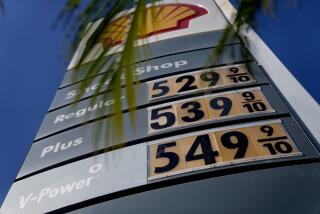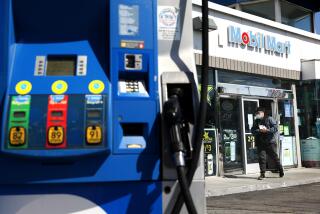Rising gas prices stoke fear, anger
WASHINGTON AND LOS ANGELES — Just as the recovery is finally looking real, surging fuel prices are once again looming as a major threat to the financial health of U.S. consumers and the broader economy.
The price surge has been particularly steep in California, in part because of maintenance at some refineries that make the state’s cleaner-burning gasoline. Statewide, average pump prices for regular gasoline crossed the $4 mark over the weekend and reached an average of $4.031 a gallon Monday, up 5% in just the last week and nearly 9% higher than a month ago.
“It doesn’t bode well for the consumer,” said Jeff Spring of the Automobile Club of Southern California. “By April or May you might see some isolated instances where you’re seeing $5” gas per gallon.
That could potentially sting President Obama’s reelection efforts as well -- with Republican primary hopefuls already blaming the Democratic incumbent for higher prices at the pump.
Oil prices have crept higher in recent weeks amid a brighter outlook for the U.S. economy and heightened tensions over Iran’s nuclear program. And Monday, crude futures jumped to a nine-month high after Iran said it had halted some oil shipments, raising the specter of even higher prices and tighter supplies ahead, especially for Europe.
Because petroleum makes up about 80% of the retail price of gasoline, increasing crude costs quickly find their way to the pump.
Nationally, drivers started this week paying on average $3.565 for a gallon of regular gas, up more than 5% in the last month. The price surge and wide variance by geography have triggered consumer anger and cries of gouging and speculation.
Newport Beach resident Daniel Heaton said he “did a double take” over the price at a Shell station in downtown Los Angeles: $4.599 a gallon for self-serve regular.
“I thought, ‘Is this the lowest one?’ It’s ridiculous,” Heaton said. Still, the 30-year-old attorney went ahead and put $64.42 worth of fuel in his tank; his employer, it turned out, was paying for it.
Down the road at a 76 station, Marisol Lopez, 31, said that the higher gas prices will force her to change how she lives.
“Life is so expensive right now,” said Lopez, who works downtown as a medical assistant.
“I’m not eating out anymore,” she said. “I’m not going out on the weekend if it’s not necessary. With gas being this expensive, I have no choice.”
But for all the complaints, CJ Kim, a sales manager for Metro PCS, said there is nothing he can do to avoid driving -- and paying for it. He said he shuttles among three stores spread around town and doesn’t get reimbursed for his mileage.
“I can’t afford not to drive,” Kim said. “What can I do? I have to live with it.”
Politicians have been picking up on drivers’ sentiments.
Republican presidential primary hopeful Rick Santorum on Monday blamed President Obama’s “radical environmentalist policies” for the increasing gasoline prices.
Campaigning in Georgia over the weekend, Newt Gingrich reiterated his pledge to lower gasoline prices by accelerating domestic oil exploration and production.
Charles Langley of the Utility Consumers’ Action Network in San Diego said consumers have a right to be angry, especially considering that oil consumption is at a multiyear low while fuel exports are near record high levels.
“Consumers have done what we’re supposed to do, and the way the refineries in California responded is by producing less gasoline,” Langley said. “And at the same time they began exporting their surplus to South America because this industry thrives on tight supply.
“The industry model is to sell half as much fuel for twice as much money.”
Economists say that higher oil prices probably already have crimped retail sales and taken a small bite out of the recovery. But their fears are for the future.
Even without turmoil in Iran and other oil-producing nations such as Egypt adding to concerns about supplies, gas prices in the U.S. typically head higher with the onset of spring as more drivers hit the road and refineries in pollution-prone regions begin the tricky switch, mandated by environmental rules, from the winter gasoline formula to summer gas, which is more expensive to produce.
“What we’re seeing is typical,” said Spring of the Automobile Club. “It’s just happening a little earlier.”
Spring said uncertainty in the Middle East is translating into higher oil prices, routine maintenance to oil refineries is driving down oil production, and even hedge fund managers who have poured billions of dollars into the commodities market are driving up the price of oil and gasoline.
No one knows how much gas prices may rise, but few see a letup in the increase any time soon.
“It’s a big concern because it’s a big chunk of money,” said William Dunkelberg, chief economist for the National Federation of Independent Business, a small-business lobbying group. As he sees it, an increase of $1 a gallon at the pumps means an extra $20 million out of the pockets of consumers and businesses every day.
“It drains consumer spending when it’s already weak,” he said. “And that’s not helpful for hiring.”
The new economic worries are eerily reminiscent of what happened about this time a year ago when political turmoil flared in Egypt and elsewhere in the oil-rich region, sending crude prices sharply higher for months. The so-called Arab Spring, combined with Japan’s earthquake in March and Europe’s debt woes, shocked the global economy and helped undercut the fragile recovery in the U.S.
Many economists believe the U.S. economy is on firmer footing today, with job growth accelerating and manufacturing strengthening. Lenders are opening up the credit spigot a bit more, and the long-sagging construction sector appears to have turned the corner.
As of December, the burden of energy costs for a typical household was still slightly below the 1970-2010 yearly average, thanks in part to the unseasonably warm winter weather in the U.S., said Gary Schlossberg, senior economist at Wells Capital Management in San Francisco.
Even though recession fears have eased since last summer, many consumers remain on edge, burdened by heavy debts and very cautious about spending. With high unemployment, sharp public spending cuts and uncertain growth prospects for Europe and slowing in China, analysts say the U.S. recovery remains highly vulnerable to external shocks, perhaps none more so than a surge in gas prices.
While auto sales have been solid in recent months, consumer spending growth overall has been tepid, moderating since late last year. Personal consumption makes up about two-thirds of U.S. economic activity.
“The economy looks pretty good at the moment,” said Schlossberg, who, like many other economists, is forecasting economic growth of 2.5% this year, up from 1.7% in 2011. “But the big question is, how big of a drag” will the U.S. see from rising oil prices?
--
matthew.stevens@latimes.com
More to Read
Inside the business of entertainment
The Wide Shot brings you news, analysis and insights on everything from streaming wars to production — and what it all means for the future.
You may occasionally receive promotional content from the Los Angeles Times.










